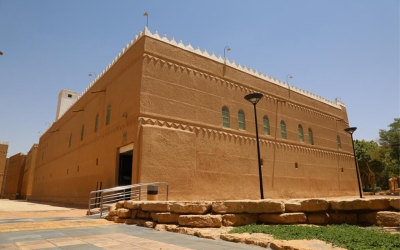




Al Murabba Historical Palace or King Abdulaziz Palace was the first palace built for King Abdulaziz Bin Abdulrahman Al Saud, the Founder of the Kingdom of Saudi Arabia. In 1938, the King moved to the palace thirty-six years following his stay in Riyadh, after he had lived in Qasr al-Hukm. The palace played a major role in the Saudi political scene. The first laws of the Kingdom saw the light of day within its premises. One of its units, the Political Division, formed the nucleus for the establishment of the current Ministry of Foreign Affairs. Moreover, important Royal Orders and decrees were issued within its walls, and it witnessed some events that changed the face of the economic and developmental future of the Kingdom.
Establishment of Al Murabba Historical Palace
In 1936, the need for rapid urbanization due to the growing population in Riyadh made it necessary to transcend the walls of the old city of Riyadh. By order from King Abdulaziz, a complex of several palaces, called the Murabba Complex, was built two km from the walls.
Construction style of Al Murabba Historical Palace
The complex was built on fertile flat land bordered by heights in the north, the Foutah and Houtah orchards to the south, Al-Batha' Valley to the east, and Abu Rafi' Valley to the west. The palaces were built with stones in their foundations, and the rest of the construction was completed with clay mixed with straw mortar which is dried in the sun. Their ceilings and doors were made from palm leaf stalks and tamarisk trunks. Moreover, they were surrounded by a seven-meter-high wall with sixteen towers. The wall was accessible through four gates in the north, south, and west.
Construction planning of Al Murabba Historical Palace
The construction was planned by King Abdulaziz and carried out by Hamad Bin Qaba' on a vast courtyard overlooked from four directions by the first and second floor rooms and units. The structures took a square and rectangular shape, in which the air enters through small semi-cylinder windows, while others were square-shaped. The walls were decorated with simple geometric Najd inscriptions. The tops of fences and walls were dyed with gypsum and fitted with back gutters to drain the water in order to avoid any damage from rain.
Structures of Murabba Complex
The Murabba Complex included several structures, most notably King Abdulaziz's Royal Court, the royal residential complex, and a mosque. The Royal Court is the only remaining structure, and is now called the Murabba Palace. King Abdulaziz used the Royal Court to carry out government functions, manage the affairs of the state, and receive guests. The Royal Court consists of two floors in the form of a square, each containing sixteen rooms. The ground floor was concerned with services, personnel and administrative tasks, and the first floor was intended for welcoming delegations and dealing with all political tasks.
Location of Al Murabba Historical Palace
The palace is currently located in the center of Riyadh, in the Murabba Neighborhood, on an area of 1,680 m, and within the King Abdulaziz Historical Center. The center is a recreational, historical, and cultural area that was developed and restored by the Royal Commission for the Development of Riyadh (currently the Royal Commission for Riyadh City). In addition to Murabba Palace, it contains King Abdulaziz Mosque, the National Museum, King Abdulaziz Public Library and King Abdulaziz Foundation for Research and Archives. The palace, which is supervised by King Abdulaziz Foundation for Research and Archives, was rehabilitated to receive visitors and welcome official delegations.
Related quizzes
Related articles

